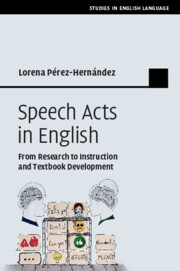Book contents
- Speech Acts in English
- Studies in English Language
- Speech Acts in English
- Copyright page
- Dedication
- Contents
- Figures
- Tables
- Acknowledgements
- Abbreviations
- 1 Introduction
- 2 What Contemporary Research Tells Us about Speech Acts
- 3 Critical Assessment of the Representation of Speech Acts in Advanced EFL Textbooks
- 4 A Cognitive Pedagogical Grammar of Directive Speech Acts I: Know-What and Know-How of Directives
- 5 A Cognitive Pedagogical Grammar of Directive Speech Acts II: Activities and Practice Materials
- 6 Conclusions
- References
- Index
4 - A Cognitive Pedagogical Grammar of Directive Speech Acts I: Know-What and Know-How of Directives
Published online by Cambridge University Press: 16 November 2020
- Speech Acts in English
- Studies in English Language
- Speech Acts in English
- Copyright page
- Dedication
- Contents
- Figures
- Tables
- Acknowledgements
- Abbreviations
- 1 Introduction
- 2 What Contemporary Research Tells Us about Speech Acts
- 3 Critical Assessment of the Representation of Speech Acts in Advanced EFL Textbooks
- 4 A Cognitive Pedagogical Grammar of Directive Speech Acts I: Know-What and Know-How of Directives
- 5 A Cognitive Pedagogical Grammar of Directive Speech Acts II: Activities and Practice Materials
- 6 Conclusions
- References
- Index
Summary
Chapter 4 applies the cognitive-constructional theoretical model of speech acts proposed in Chapter 2 to the task of providing an exhaustive description of the meaning and form of the six directive speech acts under consideration (i.e. orders, requests, beggings, suggestions, advice acts, and warnings). The ensuing portrayal of directive speech acts also includes contrastive considerations about their linguistic realisations in Spanish (L1) and English (L2). The description of the form-meaning constructional nature of the aforementioned directive speech acts takes the form of a Cognitive Pedagogical Grammar. Information is, thus, presented in an accessible, largely jargon-free manner, so that it can be used by teachers and textbook developers for the explicit teaching of the workings of directive illocutions to advanced Spanish EFL students. For each directive category, this chapter offers relevant information about its semantics (i.e. know-what) and its formal configurations (i.e. know-how).
- Type
- Chapter
- Information
- Speech Acts in EnglishFrom Research to Instruction and Textbook Development, pp. 88 - 182Publisher: Cambridge University PressPrint publication year: 2020

